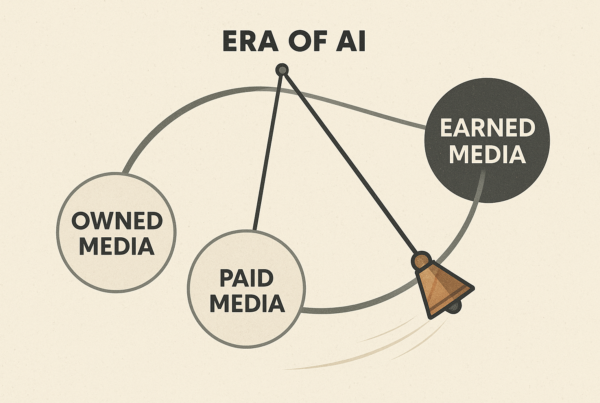 Nicholas Quah published a sharp observation in about a month ago in New York Magazine on how Hollywood publicity has evolved in today’s fractured media environment, and it struck a nerve. What he outlined for entertainment PR holds true in the tech world, too: the old playbook is dead.
Nicholas Quah published a sharp observation in about a month ago in New York Magazine on how Hollywood publicity has evolved in today’s fractured media environment, and it struck a nerve. What he outlined for entertainment PR holds true in the tech world, too: the old playbook is dead.
Not long ago, the launch path for a tech startup was practically formulaic. You’d open your email Rolodex (i.e. start with a TechCrunch reporter’s exclusive to break the news). Follow it up with a founder’s appearance on Bloomberg Technology or CNBC. Try to land a long-form podcast feature on How I Built This or Masters of Scale. In many cases, this strategy almost guaranteed you’d break through the noise, attract new customers, impress investors, and validate your product.
However, by 2025, this approach feels increasingly outdated. The landscape has changed. Attention is more fragmented. Distribution is no longer owned by a few big outlets, and many, like TechCrunch, are having their journalist ranks halved with little bandwidth to cover anyway. Furthermore, audiences, especially B2B or early adopter consumers, are harder to reach through traditional media alone.
What happened?
The internet continued to evolve, and with it, the pathways to influence. Today, trust and attention are distributed across a web of micro-communities, niche newsletters, private Slack groups, curated LinkedIn followings, YouTube explainers, Reddit threads, Telegram channels, and vertical-specific podcasts. These aren’t just fringe outposts. For many startups, it’s where real traction happens.
The challenge is that this fragmentation makes PR harder. But the upside is that it’s also more measurable and strategic than ever. Instead of chasing coverage for coverage’s sake, founders and communications teams are now focused on storytelling that drives business results: whether that’s generating inbound interest from the right buyers, validation from technical decision-makers, or raising awareness and creating differentiation in a crowded category.
There is no more “set it and forget it” launch strategy.
Each go-to-market push now requires custom thinking: Who do we actually need to influence? Where do they spend time online? What form of content do they trust? How can we influence the AI search and assistants they are now relying on for information? And which voices (not just outlets) shape how they perceive value?
A cybersecurity startup targeting CISOs will have a very different distribution strategy than a robotics company selling into operations teams, even if both are technically “B2B.” And within each audience, there may be radically different content expectations: deep-dive blogs, community Q&As, credible LinkedIn posts, technical whitepapers with a narrative hook, or partnerships with influential practitioners who command niche but highly relevant followings.
This doesn’t mean traditional media is obsolete.
The Bloomberg interview still matters. The TechCrunch exclusive still holds weight, particularly for fundraising and validation. But these moments are no longer the center of gravity. They’re just one spoke in a much larger wheel of influence.
That’s why, in 2025, the most effective tech PR isn’t just about “hits.” It’s about ecosystem building: identifying the constellation of media, creators, analysts, and communities that can authentically shape perception, and ultimately move markets.
It also means embracing new content formats. Snackable, memeable posts that the next generation of media influencers can help you make. Short-form founder videos. Behind-the-scenes dispatches. Playbook-style breakdowns of what worked (and what didn’t) during a launch. Today’s narrative must be portable and remixable, capable of living across platforms in forms that grab attention in seconds and build trust over time.
The irony is that this shift has made PR both more challenging and more effective.
PR today demands more creativity, more customization, and a deeper understanding of who your audience is and how they make decisions. As a result, few agencies and publicists will be able to do it well, and the truth is that the vast majority will fail.
However, for those who can figure out how to do it right, the impact of PR will no longer be vague. In fact, PR benefits in the current era are more science than art. It’s tied to measurable outcomes: pipeline acceleration, community growth, recruiting lifts, conversion increases, and VC investor interest.
This is especially true for startups. You don’t need to “win the internet” – but you need to win the corner of it that your buyers and believers inhabit.
In a world where the news cycle resets every 86,400 seconds, the PR teams that thrive are those that treat storytelling as a growth strategy. They’re part content studio, part strategist, part distribution engine. They don’t just chase the press. They engineer narratives and influence.
So yes, the playbook is gone. But what’s replaced it is better.
For those willing to delve deeper, find the right narrative, and meet their audience where they are, not where they used to be, the rewards may be greater than what some are calling the PR golden days of the past.
And the brands that understand this, and build their comms strategies accordingly, are already pulling ahead.




